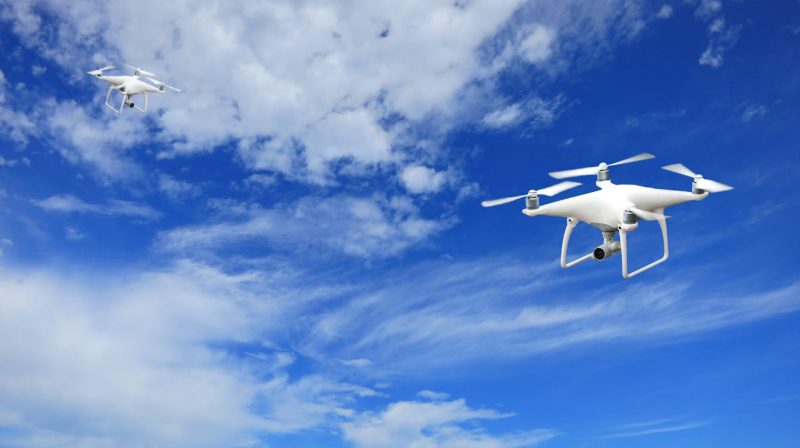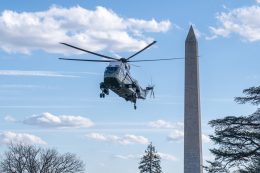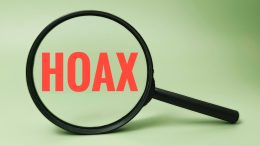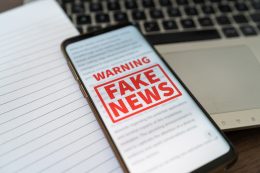Americans are waking up to find drones hovering over their backyards capturing every private moment.
Government agencies insist they need this technology for public safety.
But Big Brother just got wings and one California lawsuit could decide if government can spy on you from the sky.
Woman discovers drone photographed her naked in her own home
Nichola Schmitz was going about her day on her rural California farm when a worker pointed to the sky.
A drone was hovering overhead recording her property.
Schmitz is deaf and never heard the buzzing aircraft that had been spying on her home.
She immediately ran into her bedroom and closed the blinds as the realization hit her — the drone may have photographed her naked earlier that day after she bathed.
"This horrible experience has shattered my sense of privacy and security," Schmitz said. "I'm afraid to open my blinds or go outside to use my hot tub because who knows when the county's drone could be spying on me."¹
Days later she received notice from Sonoma County code enforcement citing violations on her property.
The county confirmed it used drones to identify the violations.
Schmitz has already paid $25,000 to resolve the issue and faces $10,000 in additional fees.²
Between 2019 and 2024, Sonoma County code enforcement deployed drones more than 700 times, capturing at least 5,600 images of private properties.³
The drones flew as low as 100 feet above homes equipped with high-powered cameras and zoom lenses.
They photographed swimming pools, hot tubs, outdoor showers, and even peered through curtainless windows.
All without warrants.
Between 2020 and 2024, the county levied more than $3 million in fines in cases that relied on drone surveillance.⁴
ACLU files landmark lawsuit challenging warrantless surveillance
In June 2025, the ACLU Foundation of Northern California filed a lawsuit in Sonoma County Superior Court challenging what they call an illegal drone surveillance program.
The suit was filed on behalf of three longtime residents including Schmitz.
"We all have the right to go about our lives in privacy in and around our homes without having to worry about a government drone flying overhead and recording us without a warrant or our knowledge," Matt Cagle, senior staff attorney with the ACLU of Northern California, said.⁵
The lawsuit invokes California's 1985 People v. Cook ruling, which prohibited government from conducting aerial surveillance of private homes without a warrant.⁶
County officials launched the drone program six years ago claiming they needed it to address unpermitted cannabis grows in hard-to-reach rural areas.
But it quickly morphed into something much bigger.
By 2024, nearly half of the county's drone flights targeted unrelated code violations like unpermitted construction, junkyard conditions, and zoning issues.⁷
The lawsuit also accuses Permit Sonoma of systematically concealing the drone program from the public, press and courts.
Notices of violation rarely disclosed that evidence came from drones.
County officials even deliberated over how to respond when a reporter asked whether they used drones to look for code violations.
"Records show that the county is aware that these drones invade private spaces" and ensuing cases are "upending people's finances, and yet they've continued to grow and grow the program," Cagle said. "Drones are supercharging the government's ability to bring down the power of the state on people."⁸
Courts split on whether drones violate Fourth Amendment
The Supreme Court hasn't ruled on whether warrantless drone surveillance violates the Fourth Amendment.
That's left lower courts scrambling to apply decades-old precedents about manned aircraft to modern drone technology.
But drones are fundamentally different from helicopters and airplanes.
Unlike noisy manned aircraft that alert people they're being watched, drones can silently and unobtrusively gather massive amounts of data at a fraction of the cost.⁹
They're vastly smaller and fly at lower altitudes.
Drones can get into spaces under eaves or between buildings that planes and helicopters can never enter.
Some courts recognize these differences require new constitutional analysis.
The Michigan Court of Appeals held in 2021 that government's use of drone surveillance over private property constitutes a search under the Fourth Amendment requiring a warrant.¹⁰
"Low-altitude, unmanned, specifically-targeted drone surveillance of a private individual's property is qualitatively different from the kinds of human-operated aircraft overflights" previously approved by courts, the Michigan court ruled.
But Michigan's Supreme Court later gutted that protection.
In 2024, Michigan's highest court ruled government officials can use evidence from warrantless drone searches as long as they're investigating civil violations instead of crimes.¹¹
Robert Frommer, an attorney with the Institute for Justice, called the decision "wrong and dangerous," saying it effectively endorsed unconstitutional searches "as long as the person searching does not have a policeman's hat."¹²
"The Fourth Amendment is not about the police, it's about the government," Frommer explained.
Eighteen states require warrants but loopholes remain
At least 18 states now require law enforcement to obtain search warrants before using drones for surveillance.¹³
These include Alaska, Florida, Idaho, Illinois, Indiana, Iowa, Maine, Montana, Nevada, North Carolina, North Dakota, Oregon, Tennessee, Texas, Utah, Vermont, Virginia and Wisconsin.
Virginia's law is particularly strong, prohibiting state and local law enforcement from using drones except during execution of a search warrant or administrative inspection warrant.¹⁴
But even states with warrant requirements include loopholes.
Minnesota's law permits police to use drones to collect data in public areas if "there is reasonable suspicion of criminal activity" — an exemption at risk of being broadly applied.¹⁵
And many states still have no comprehensive laws regulating government drone use at all.
"More police departments are using drones, and there just aren't the guardrails in place to prevent civil rights violations and address privacy and surveillance rules," Molly Kleinman, managing director of the University of Michigan's Science, Technology, and Public Policy Program, warned.¹⁶
Trump orders accelerated drone expansion despite privacy concerns
President Trump's June 2025 executive orders on drones accelerated government's ability to deploy this surveillance technology.
Before Trump's action, police departments waited up to 11 months for Federal Aviation Administration approval to launch Drone as First Responder programs.
Now departments get approval in days.¹⁷
By late 2024, approximately 1,500 police and sheriff departments were flying drones — a 150% jump since 2018.¹⁸
That number is exploding as regulatory barriers fall.
But privacy advocates see it differently.
The Electronic Frontier Foundation blasted DFR programs as "the latest aerial police surveillance push" threatening constitutional rights.
The problem isn't just drones flying overhead but what government does with the data they collect.
Advanced drones powered by AI can read license plates, monitor crowds, and even measure a person's heart rate, breathing, blood pressure and oxygen levels from 500 meters away.¹⁹
Some drones function as flying automated license plate readers tracking vehicles across entire cities.
"Basically, the drone is just flying, taking all the information," Mauricio Kleinburg, director of technology at security firm Seguritech, explained. "The real firepower comes with what you do with analytics, with image AI, or all the sensors in the police central or in the data center."²⁰
Where warrantless surveillance leads if courts don't stop it
If Sonoma County wins this case, every government agency in America gets the green light to deploy surveillance drones over your property without warrants.
Code enforcement, tax assessors, environmental regulators, even HOAs with government contracts could send drones to spy on your backyard, peer through your windows, and catalog everything you own.
The technology exists right now to create a surveillance grid that would make Communist China jealous.
Government agencies just need courts to bless warrantless surveillance, and the floodgates open.
This isn't speculation.
Police departments in Humboldt, Mendocino and Yolo counties have already developed drone programs following Sonoma's model.²¹
The case could set a precedent affecting law enforcement agencies far beyond California.
"This is an important test case," Cagle explained. "While there are laws relating to when private citizens and private individuals can use drones, when it comes to laws relating to government use of drones, it's kind of the Wild West."²²
Constitutional protections hang by a thread as Big Tech meets Big Government
The Supreme Court's 1967 Katz v. United States decision established that a government action constitutes a search under the Fourth Amendment if it violates a person's "reasonable expectation of privacy."
But outdated precedents from the 1980s involving manned aircraft are being stretched to justify warrantless drone surveillance.
This is the same pattern Americans saw with digital surveillance.
Government and Big Tech partnered to create a surveillance system our Founders never imagined — tracking your emails, phone calls, web searches, and location data.
Now they're bringing that surveillance model to physical space through drones equipped with facial recognition, license plate readers, and AI analytics.
That data doesn't disappear.
It gets stored, analyzed, and shared between agencies — building detailed profiles of law-abiding citizens who never committed crimes.
China uses this exact technology to run its social credit system, tracking citizens' every move and punishing dissent.
American government agencies insist they'd never abuse surveillance powers like that.
But they said the same thing about phone surveillance, internet monitoring, and license plate readers — until whistleblowers revealed the truth about mass spying programs.
State supreme courts are starting to recognize constitutional protections that federal courts won't.
Six months after the Supreme Court approved warrantless aerial surveillance in California v. Ciraolo, the California Supreme Court held in People v. Cook that under the state's constitution, individuals have a reasonable expectation that government won't conduct warrantless surveillance of their backyards from the air.²³
Hawaii, Vermont and Alaska have similarly relied on their state constitutions to find warrantless aerial surveillance improper.
But protection from warrantless aerial surveillance will have to come from the states, the Electronic Frontier Foundation concluded.²⁴
Sonoma County loosened its drone policies over time.
In 2019, inspectors were required to have a complaint before deploying a drone.
Now officials can launch "discretionary proactive investigations" without any complaint at all.²⁵
"They can't just invade people's privacy for building a deck without a permit," ACLU attorney David Loy said. "How many hundreds of people in Sonoma County's rights have been violated?"²⁶
The answer to whether government can freely spy on Americans from the sky without warrants may soon be decided by California courts.
Big Brother's drones are already in the air.
The only question is whether Americans will ground them while they still can.
¹ KQED, "Sonoma County Deployed Drones 700 Times Since 2019, Says ACLU Lawsuit," kqed.org, June 6, 2025.
² Ibid.
³ Davis Vanguard, "ACLU Sues Sonoma County over Warrantless Drone Surveillance Program," davisvanguard.org, August 4, 2025.
⁴ Ibid.
⁵ Ibid.
⁶ DroneXL, "AI-Powered Police Drones Reach 1,500 US Departments As Landmark Privacy Lawsuit Tests Legal Limits," dronexl.co, October 2025.
⁷ DroneXL, "Sonoma County Faces Lawsuit Over Drone Surveillance: ACLU Calls It A 'Runaway Spying Operation,'" dronexl.co, June 7, 2025.
⁸ Press Democrat, "ACLU sues Sonoma County over use of drone surveillance for code enforcement," pressdemocrat.com, June 5, 2025.
⁹ Electronic Frontier Foundation, "Backyard Privacy in the Age of Drones," eff.org, August 27, 2024.
¹⁰ Foster Swift, "Michigan Court of Appeals Holds Drone Surveillance a Search Under Fourth Amendment," fosterswift.com, November 18, 2021.
¹¹ Reason, "Michigan Supreme Court allows evidence collected by drone, without a warrant," reason.com, May 8, 2024.
¹² Ibid.
¹³ Police1, "Key considerations for a law enforcement drone policy," police1.com, March 11, 2024.
¹⁴ Code of Virginia, "§ 19.2-60.1. Use of unmanned aircraft systems by public bodies; search warrant required," law.lis.virginia.gov.
¹⁵ Brookings, "How to regulate police use of drones," brookings.edu, September 24, 2020.
¹⁶ University of Michigan STPP, "Kleinman quoted on police drone use and privacy concerns," stpp.fordschool.umich.edu, April 23, 2025.
¹⁷ Police1, "2025: The year drone as first responder programs went mainstream," police1.com, June 27, 2025.
¹⁸ Axios, "AI drones are America's newest cops," axios.com, October 2025.
¹⁹ Ibid.
²⁰ Ibid.
²¹ Redheaded Blackbelt, "Lawsuit Over Sonoma County Drone Use Raises Privacy Questions," kymkemp.com, July 22, 2025.
²² KQED, "Sonoma County Deployed Drones 700 Times Since 2019, Says ACLU Lawsuit," kqed.org, June 6, 2025.
²³ Electronic Frontier Foundation, "Backyard Privacy in the Age of Drones," eff.org, August 27, 2024.
²⁴ Ibid.
²⁵ DroneXL, "Sonoma County Faces Lawsuit Over Drone Surveillance: ACLU Calls It A 'Runaway Spying Operation,'" dronexl.co, June 7, 2025.
²⁶ Press Democrat, "ACLU sues Sonoma County over use of drone surveillance for code enforcement," pressdemocrat.com, June 5, 2025.
















